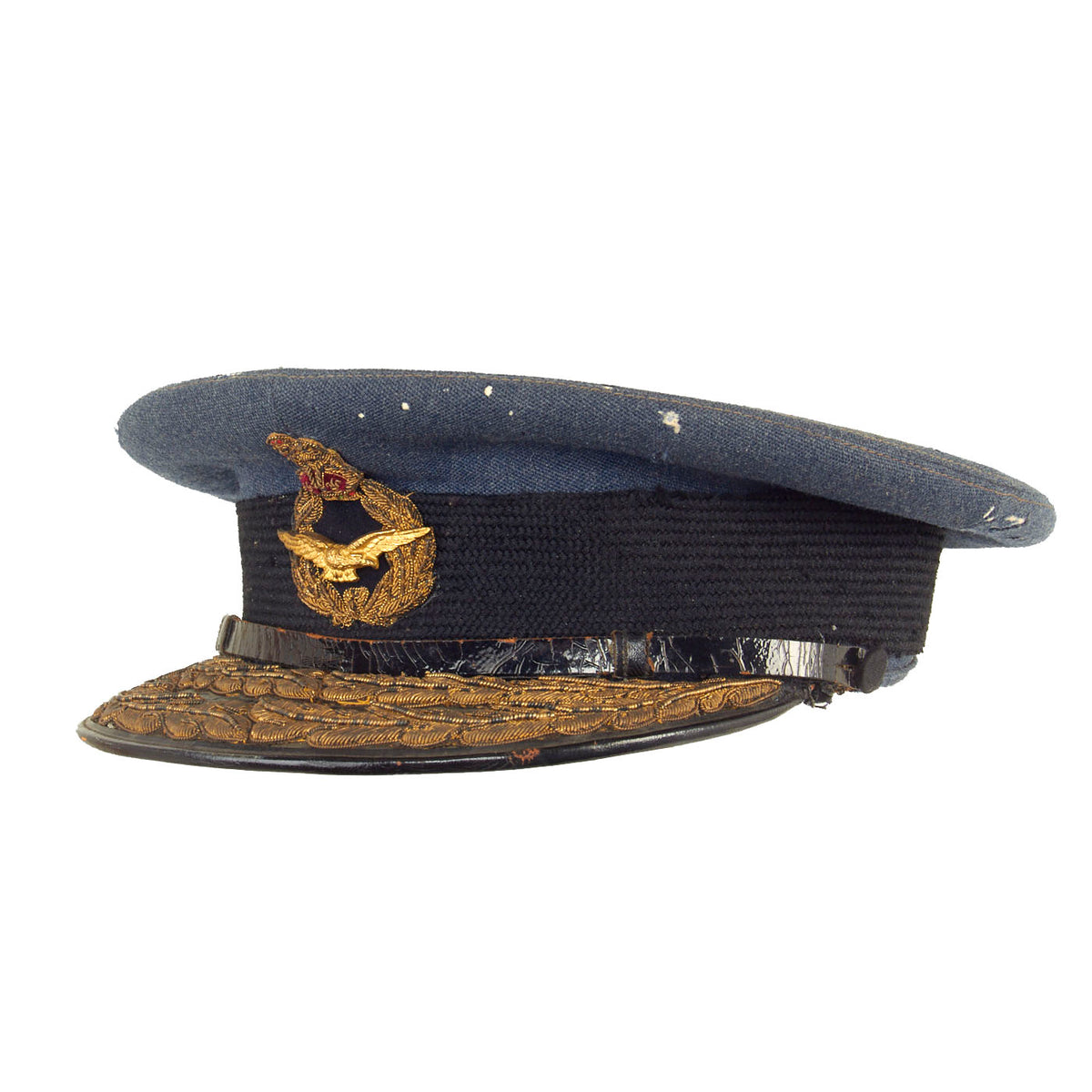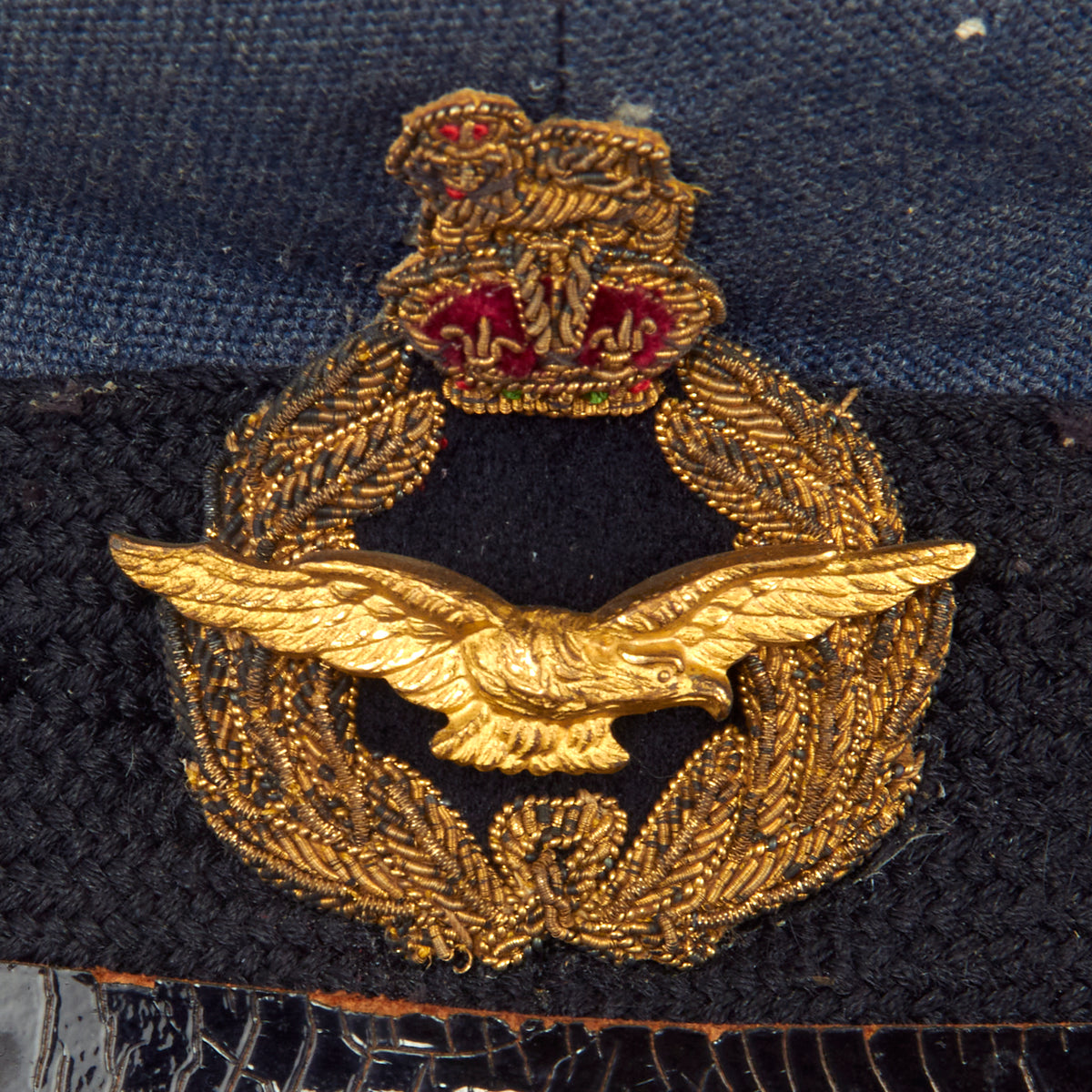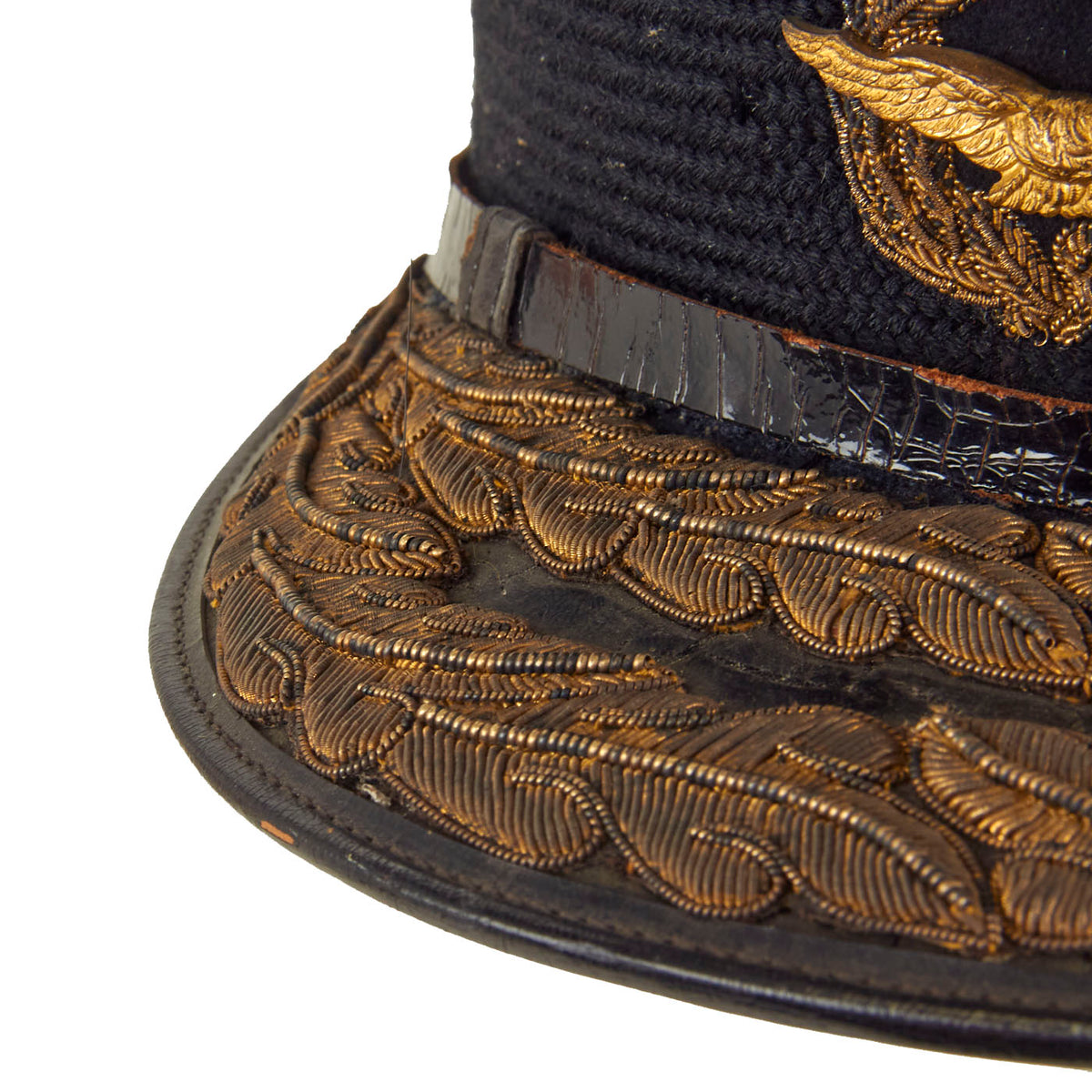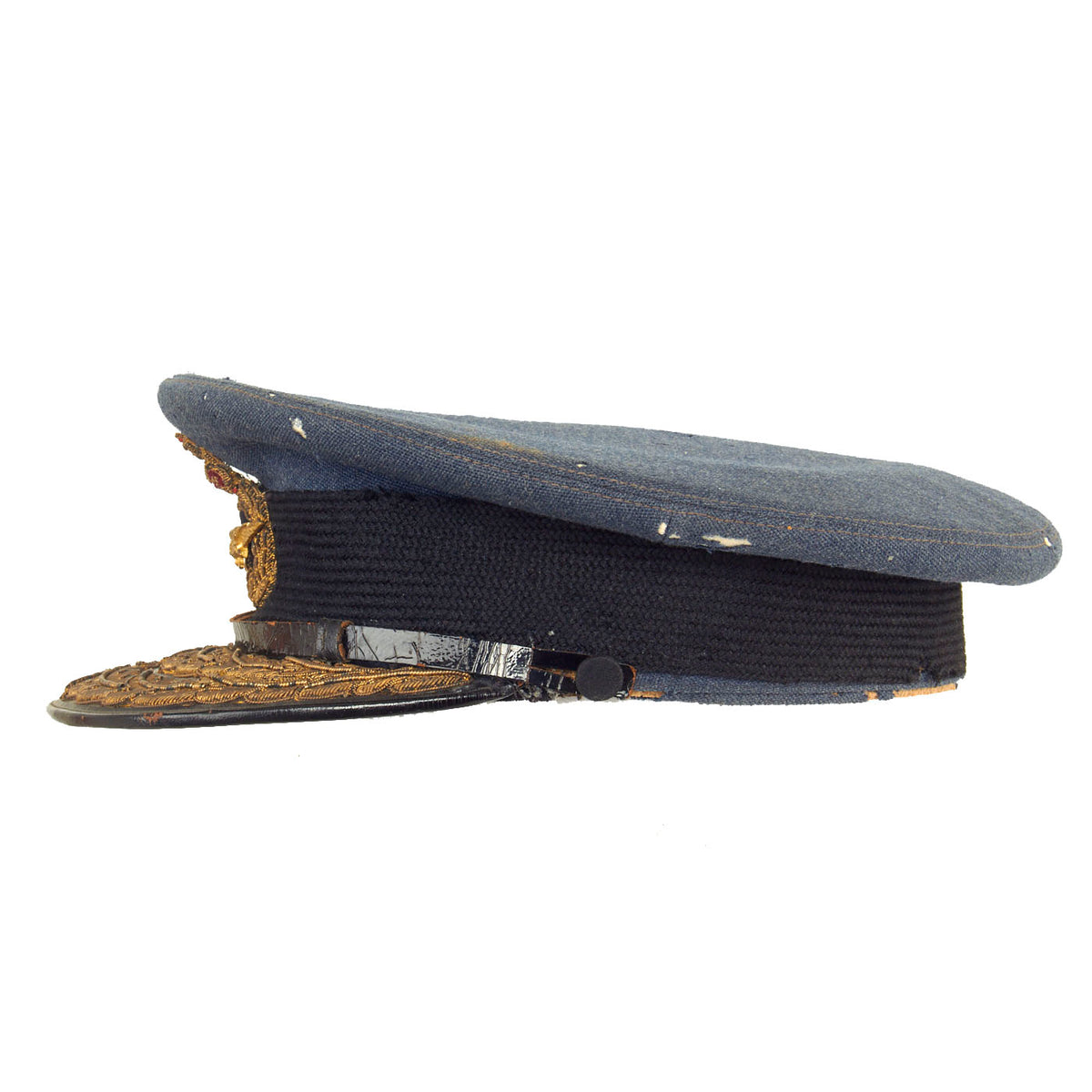Original British WWII British Royal Air Force RAF Air Marshal’s Peaked Visor Cap Original Items
$ 595,00 $ 178,50
Original Item: Only One Available. This is a fantastic example of a hard to find, British RAF Air Marshals’ blue wool peaked visor cap. Prior to the adoption of RAF-specific rank titles in 1919, it was suggested that the RAF might use the Royal Navy’s officer ranks, with the word “air” inserted before the naval rank title. For example, the rank that later became air marshal would have been air vice-admiral. The Admiralty objected to any use of their rank titles, including this modified form, and so an alternative proposal was put forward: air-officer ranks would be based on the term “ardian”, which was derived from a combination of the Gaelic words for “chief” (ard) and “bird” (eun), with the term “second ardian” or “wing ardian” being used specifically for the rank equivalent to a vice-admiral and lieutenant-general. However, air marshal was preferred and has been used since its adoption in August 1919. Sir Hugh Trenchard, the incumbent Chief of the Air Staff when the rank was introduced, became the first air marshal on 11 August 1919.
This example is unfortunately not marked with a name or service number, but it does not take away from the beauty of the item and the rarity of it. The visor cap is in lovely displayable condition, but it does have extensive moth nips present on the crown of the visor. It is constructed of the usual Royal Air Force blue barathea wool with a black mohair band. The padded bullion embroidered cap badge has a KING’S CROWN on the top. It has the correct laurel leaves below a gold washed metal eagle. Two rows of “scrambled eggs” on the visor, a common nickname for the golden oak leaf sprigs used to symbolize general officers as well as Air Officers in this case.
Offered in overall very good condition with the expected nips here and there mainly located on the top portion. There is light wear to the sweatband, and some dirt staining on the front where the forehead would rest as well as stitching loss resulting in partial detach. Size is approximately 7 1/4 US (58cm).
Comes more than ready for further research and display.
The RAF underwent rapid expansion prior to and during the Second World War. Under the British Commonwealth Air Training Plan of December 1939, the air forces of British Commonwealth countries trained and formed “Article XV squadrons” for service with RAF formations. Many individual personnel from these countries, and exiles from occupied Europe, also served with RAF squadrons. By the end of the war the Royal Canadian Air Force had contributed more than 30 squadrons to serve in RAF formations, similarly, approximately a quarter of Bomber Command’s personnel were Canadian. Additionally, the Royal Australian Air Force represented around nine percent of all RAF personnel who served in the European and Mediterranean theatres.
In the Battle of Britain in 1940, the RAF defended the skies over Britain against the numerically superior German Luftwaffe. In what is perhaps the most prolonged and complicated air campaign in history, the Battle of Britain contributed significantly to the delay and subsequent indefinite postponement of AH’s plans for an invasion of the United Kingdom (Operation Sea Lion). In the House of Commons on 20 August, prompted by the ongoing efforts of the RAF, Prime Minister Winston Churchill eloquently made a speech to the nation, where he said “Never in the field of human conflict was so much owed by so many to so few”.
The largest RAF effort during the war was the strategic bombing campaign against Germany by Bomber Command. While RAF bombing of Germany began almost immediately upon the outbreak of war, under the leadership of Air Chief Marshal Harris, these attacks became increasingly devastating from 1942 onward as new technology and greater numbers of superior aircraft became available. The RAF adopted night-time area bombing on German cities such as Hamburg and Dresden, and developed precision bombing techniques for specific operations, such as the “Dambusters” raid by No. 617 Squadron, or the Amiens prison raid known as Operation Jericho.
Fast Shipping with Professional Packaging
Thanks to our longstanding association with UPS FedEx DHL, and other major international carriers, we are able to provide a range of shipping options. Our warehouse staff is expertly trained and will wrap your products according to our exact and precise specifications. Prior to shipping, your goods will be thoroughly examined and securely secured. We ship to thousands clients each day across multiple countries. This shows how we're dedicated to be the largest retailer on the internet. Warehouses and distribution centres can be located throughout Europe as well as the USA.
Note: Orders with more than one item will be assigned a processing date depending on the item.
Before shipping before shipping, we'll conduct a thorough inspection of the items you have ordered. Today, the majority of orders will be delivered within 48 hours. The delivery time will be between 3-7 days.
Returns
The stock is dynamic and we cannot completely manage it because multiple stakeholders are involved, including our factory and warehouse. So the actual stock may alter at any time. It's possible that you may not receive your order once the order has been made.
Our policy is valid for a period of 30 days. If you don't receive the product within 30 days, we are not able to issue a refund or an exchange.
You can only return an item if it is unused and in the same state as the day you received it. You must have the item in its original packaging.
Related products
Uncategorized
Uncategorized
Uncategorized
Uncategorized
Uncategorized
Australian WWII Owen MK1 Machine Carbine SMG Custom Fabricated Replica with Sling Original Items
Uncategorized
Uncategorized
Uncategorized
Armoured Fighting Vehicles of the World: AFVs of World War One (Hardcover Book) New Made Items
Uncategorized
Uncategorized
Uncategorized
Uncategorized
Uncategorized
Uncategorized
Uncategorized
Band of Brothers ORIGINAL GERMAN WWII Le. F.H. 18 10.5cm ARTILLERY PIECE Original Items
Uncategorized
Uncategorized












































































